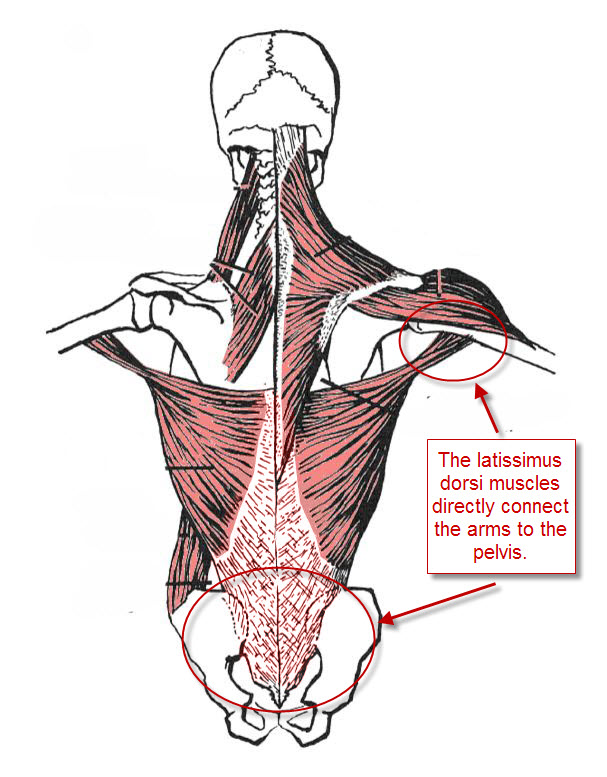
Figure based on http://www.dartmouth.edu/~humananatomy/figures/chapter_8/8-4.HTM.
Here's a description of the latissimus dorsi muscle from Answers.com:
It has its origins on the lower six thoracic vertebrae and all lumbar vertebra, the posterior sacrum, the iliac crest, and the lower three or four ribs. Insertions are on the inter-tubercular groove of the humerus. The lats primary actions about the shoulders are extension, adduction, and medial rotation. The lats play an important part in bringing the arm down in a power stroke, as in striking a blow, swimming the front crawl, and rowing. (Emphasis added. BDC)
Why is this important? Hard-style karate (shuri-te) from Matsumura and Itosu is based on a revolutionary shift from upper-body muscle to lower-body muscle. Matsumura abandoned the weight-lifting habits of Chinese/Naha styles and substituted low stances and leg development. Leg muscles are much more powerful than arm muscles. The only problem is getting the leg power up to the arms so it can be applied. This is where the latissimus dorsi muscles come it.
I have often been admonished to put my elbow in the "right spot" while blocking, which is about one fist away from the ribs and inside the outline of the body. In this "chamber" spot, the arm becomes almost immovable for techniques like downblock, inside and outside block, and knife-hand block. It is also used in wedge block, hook punch, and various other techniques. We lock the arm down and then use the hips to block. (How many times have you heard your instructor say, "Block with your hips!")
In the "chambered" position, the latissimus dorsi muscle of the blocking arm is powerfully contracted, pulling the arm and shoulder down in a tight connection to the pelvis. This locks the arm/shoulder into a tight, almost rigid, relationship to the hips. Leg power (hip rotation, hip vibration) is transmitted directly to the arm, making it very strong for blocking and striking.
Similarly, I've been trained to use hiki-te, pullback hand, with nearly every hand technique. This contracts the opposite latissimus dorsi muscle, rigidly locking both shoulders down in a tight connection to the hips.
It is no coincidence that elbow position is critical to moving hip power to the arms. No wonder the sensei emphasize it so relentlessly!
As a side note, it has come to my attention that jujutsu techniques seem stronger when the two hands are not held at the same level. When applying an arm bar, for instance, the technique seems weak when both hands are up at the level of the shoulders. Pull his wrist down by lowering your hand, however, and the technique becomes strong. Why? Because lowering your hand chambers your elbow and gives you the arm-to-hip connection. This lets you use your leg muscles to set the arm bar, instead of trying to do it all with your arms.
Build up your lats. If you are making an effort to do powerful hiki-te, this muscle-building will happen anyway. Karate demands it.



